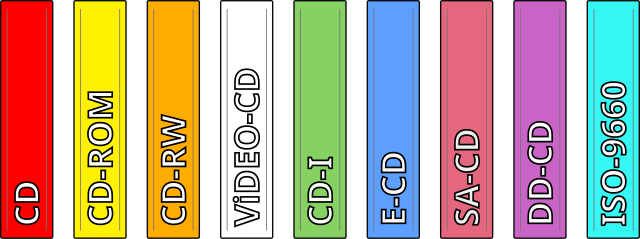Top Qs
Timeline
Chat
Perspective
Rainbow Books
Book series that contains the specifications of Compact Discs From Wikipedia, the free encyclopedia
Remove ads
The Rainbow Books are a collection of CD format specifications, generally written and published by the companies involved in their development, including Philips, Sony, Matsushita and JVC, among others.


A number of these specifications have been officially adopted by established standards bodies, including the ISO, IEC, and ECMA.
Remove ads
Red Book (1980)
Yellow Book (1983)
Green Book (1986)
Orange Book (1990)
Orange is a reference to the fact that red and yellow mix to orange. This correlates with the fact that CD-R and CD-RW are capable of audio ("Red") and data ("Yellow"); although other colors (other CD standards) that do not mix are capable of being burned onto the physical medium. Orange Book also introduced the standard for multisession writing.
- CD-MO (Magneto-Optical)[11]
- CD-R (Recordable) alias CD-WO (Write Once) alias CD-WORM (Write Once, Read Many) – originally developed by Sony and Philips,[12] it was partially standardized as ECMA-394.[13]
- CD-RW (ReWritable) alias CD-E (Eraseable) – originally developed by Philips, Sony and Ricoh,[14] it was partially standardized as ECMA-395.[15]
Remove ads
Beige Book (1992)
- Photo CD (Photo) — proprietary standard jointly developed by Philips and Eastman Kodak;[16] never released to the public[17]
White Book (1993)
The White Book refers to a standard of compact disc that stores pictures and video.
- CD-i Bridge[18] - a bridge format between CD-ROM XA and the Green Book CD-i, which is the base format for Video CDs, Super Video CDs and Photo CDs.
- VCD (Video) – a standard jointly developed and published by JVC, Matsushita, Philips and Sony.[19]
Remove ads
Blue Book (1995)
The Blue Book is a compact disc standard that defines the Enhanced Music CD format, which combines audio tracks and data tracks on the same disc.
- E-CD/CD+/CD Extra (Enhanced)[21] – a standard jointly developed and published by Microsoft, Philips and Sony
Scarlet Book (1999)
Scarlet color of this book is a reference to the Red Book, which defines original CDDA.
Purple Book (2000)
A standard developed by Philips and Sony in the late 1990s, with over 1 GB in capacity and recordable/re-recordable capabilities.[23]
See also
- ISO 9660, a 1986 filesystem standard used in conjunction with CD-ROM formats.
- Orange-Book-Standard, a decision named after the Compact Disc standard, issued in 2009 by the German Federal Court of Justice on the interaction between patent law and standards
References
External links
Wikiwand - on
Seamless Wikipedia browsing. On steroids.
Remove ads
